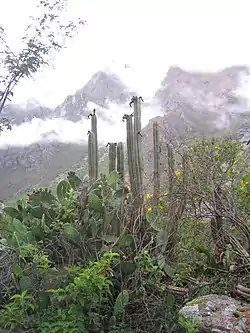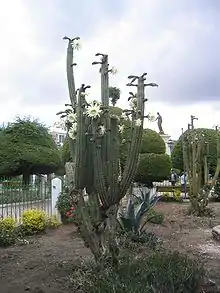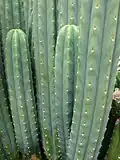Trichocereus macrogonus
Trichocereus macrogonus, synonym Echinopsis macrogonus, is a species of cactus found in Ecuador, Peru and Bolivia.[2] Two varieties are accepted as of September 2023: var. macrogonus and var. pachanoi. Plants contain varying amounts of the psychoactive alkaloid mescaline. They have been used both ritually and intraditional medicine from pre-Columbian times. Trichocereus macrogonus is one of a number of similar species that may be called San Pedro cactus. Indigenous names include achuma and huachuma, although these too may be applied to similar species.
| Trichocereus macrogonus | |
|---|---|
 | |
| Trichocereus macrogonus var. pachanoi – the tall cactus in the mid-foreground, in its natural habitat in Peru | |
| Scientific classification | |
| Kingdom: | Plantae |
| Clade: | Tracheophytes |
| Clade: | Angiosperms |
| Clade: | Eudicots |
| Order: | Caryophyllales |
| Family: | Cactaceae |
| Subfamily: | Cactoideae |
| Genus: | Trichocereus |
| Species: | T. macrogonus |
| Binomial name | |
| Trichocereus macrogonus | |
| Synonyms | |
|
Of the species:[2]
Of T. macrogonus var. macrogonus:[3]
Of T. macrogonus var. pachanoi:[4]
| |
Description
The species has erect stems, 2.5–5 m (8–16 ft) tall, with branches generally with a diameter of 6–15 cm (2–6 in), occasionally more. At the base of the stem there are usually seven or eight ribs. Generally the species has relatively few ribs, typically six to eight, occasionally five or nine. The circular areoles are 6 mm (0.2 in) across, grey or dark brown, with needle-like spines, and are spaced more than 2.5 cm (1.0 in) apart. The number and length of the spines varies. In T. macrogonus var. macrogonus, older areoles may have up to 20, with three or four prominent, longer and more robust central spines up to 5 cm (2.0 in) long. In var. pachanoi, the older areoles may have only three to seven shorter and thinner spines. The spines are darker at the end. The flowers are carried mostly near the top of the stems. In total they may be up to 21 cm (8.3 in) long. The tepals may be pale yellow or yellowish green, rarely pink. The small seeds are broadly ovoid, 0.9–1.1 mm (0.04–0.04 in) long.[5]
.jpg.webp) Stem of Trichocereus macrogonus var. macrogonus
Stem of Trichocereus macrogonus var. macrogonus Plant of Trichocereus macrogonus var. pachanoi
Plant of Trichocereus macrogonus var. pachanoi Trichocereus macrogonus var. macrogonus flower
Trichocereus macrogonus var. macrogonus flower Trichocereus macrogonus var. pachanoi flower
Trichocereus macrogonus var. pachanoi flower Trichocereus macrogonus var. macrogonus flower and buds side view
Trichocereus macrogonus var. macrogonus flower and buds side view
Taxonomy
The first description as Cereus macrogonus by Joseph zu Salm-Reifferscheidt-Dyck was published in 1850.[6] The specific epithet macrogonus is derived from the Greek words makros for 'large' and gonia for 'edge' and refers to the ribs of the species. Vincenzo Riccobono placed the species in the genus Trichocereus in 1909.[7] Heimo Friedrich and Gordon Douglas Rowley placed the species in the genus Echinopsis in 1974 as Echinopsis macrogona.
Many other names have been applied to Trichocereus macrogonus. The taxonomy of the species was clarified in 2012 by Sofía Albesiano and Roberto Kiesling. In particular, they sank Trichocereus peruvianus and Trichocereus pachanoi into T. macrogonus, treating T. pachanoi as T. macrogonus var. pachanoi. The number and size of the spines was regarded as a distinguishing feature of the two varieties, although this was noted to be a variable character, influenced by environmental conditions: cultivated plants develop more spines when moved to sunnier positions.[8]
As of 2023, Plants of the World Online accepted two varieties:[2]
| Image | Subspecies | Synonyms | Description | Distribution |
|---|---|---|---|---|
.jpg.webp) | Trichocereus macrogonus var. macrogonus |
|
longer spines, blue green stems sometimes with notches, thicker stem diameter | west and south Peru to Bolivia[3] |
 | Trichocereus macrogonus var. pachanoi (Britton & Rose) Albesiano & R.Kiesling |
|
small spines, dark green to blue green stems, thinner stem diameter | south Ecuador to Peru[4] |
Distribution
Plants of the World Online regards the species as native to Peru, Ecuador, and Bolivia, and introduced to central Chile, Colombia, mainland Spain and the Canary Islands.[2] However, plants are widely cultivated making the true origins of the species difficult to determine. It has been speculated that the original native distribution may only be the high valleys of Peru and perhaps also northwestern Bolivia.[8]
Mescaline content
This species of cactus has been used by humans for several millennia. The oldest find was located in the Guitarrero Cave, in the Áncash region in Peru. In this cave, inhabited continuously since 8600 BCE, a high concentration of T. macrogonus pollen from the oldest phase of human occupation has been detected, as well as some fragments of cactus, which would testify to the intentional introduction of this plant inside the cave.[9] Ritual uses of the species are depicted on pre-Columbian Peruvian ceramics and other archaeological objects, with one use dated to about 1300 BCE. Indigenous names include achuma and huachuma.[8]
Trichocereus macrogonus is one of a number of species native to the Andes that have been reported to contain the psychoactive alkaloid mescaline (reports may use various synonyms of the currently accepted names).[10] Another species is Echinopsis lageniformis. All the columnar species thought to be psychoactive have been called "San Pedro" in Spanish. Reported concentrations of mescaline vary widely, with causes suggested to include: taxonomic uncertainty leading to difficulties in identification; genetic differences between species and within populations; environmental factors, such as temperature and water availability, affecting plants during growth; and variations in laboratory techniques.[11]
Some studies have reported no mescaline content in wild-harvested Peruvian specimens of T. macrogonus,[12] and in plants grown in Europe.[13] In those studies that have compared different species and cultivars, the concentrations found were very variable. In samples identified as Echinopsis pachanoi (i.e. T. macrogonus var. pachanoi), the lowest found was 0.4% of dry weight compared to 4.7% for a form on sale in traditional Peruvian shamans' markets.[11] The plants used by shamans are likely to be cultivars they have selected for their mescaline content.[8]
References
- Assessment), Jose Roque (Global Cactus (2011-05-05). "The IUCN Red List of Threatened Species". IUCN Red List of Threatened Species. Retrieved 2023-09-26.
- "Trichocereus macrogonus (Salm-Dyck) Riccob." Plants of the World Online. Royal Botanic Gardens, Kew. Retrieved 2023-09-25.
- "Trichocereus macrogonus var. macrogonus". Plants of the World Online. Royal Botanic Gardens, Kew. Retrieved 2023-09-25.
- "Trichocereus macrogonus var. pachanoi (Britton & Rose) Albesiano & R.Kiesling". Plants of the World Online. Royal Botanic Gardens, Kew. Retrieved 2023-09-25.
- Albesiano, Sofía (2012), "A New Taxonomic Treatment of the Genus Trichocereus (Cactaceae) in Chile", Haseltonia, 18: 116–139, doi:10.2985/026.018.0114
- Salm-Reifferscheidt, Joseph; Georgi, Carl (1850). Cacteae in horto Dyckensi cultae anno 1849, secundum tribus et genera digestae : additis adnotationibus botanicis characteribusque specierum in enumeratione diagnostica cactearum Doct. Pfeifferi non descriptarum /. Bonnae: Apud Henry & Cohen, typis C. Georgii. doi:10.5962/bhl.title.120333.
- Palermo, Orto botanico di (1908). "Bollettino del R. Orto Botanico di Palermo". Libreria internazionale, Alberto Reber. Retrieved 2023-09-26.
- Albesiano, Sofía & Kiesling, Roberto (2012), "Identity and neotypification of Cereus macrogonus, the type species of the genus Trichocereus (Cactaceae)" (PDF), Haseltonia, 17: 24–34, doi:10.2985/1070-0048-17.1.3, retrieved 2023-09-26
- Samorini, Giorgio (2019-03-29). "The oldest archeological data evidencing the relationship of Homo sapiens with psychoactive plants: A worldwide overview". Journal of Psychedelic Studies. Akademiai Kiado Zrt. 3 (2): 63–80. doi:10.1556/2054.2019.008. ISSN 2559-9283.
- Mchem, Benjamin Bury (2021-08-02). "Could Synthetic Mescaline Protect Declining Peyote Populations?". Chacruna. Archived from the original on 2021-08-02. Retrieved 2021-10-17.
- Ogunbodede, Olabode; McCombs, Douglas; Trout, Keeper; Daley, Paul & Terry, Martin (2010). "New mescaline concentrations from 14 taxa/cultivars of Echinopsis spp. (Cactaceae) ("San Pedro") and their relevance to shamanic practice". Journal of Ethnopharmacology. 131 (2): 356–362. doi:10.1016/j.jep.2010.07.021. PMID 20637277.
- Djerassi, Carl; Liu, L.H.; Farkas, E.; Lippman, A.E.; Lemin, A.J.; Geller, L.E.; McDonald, R.N. & Taylor, B.J. (1955). "Terpenoids. XI.1 Investigation of Nine Cactus Species. Isolation of Two New Triterpenes, Stellatogenin and Machaeric Acid". Journal of the American Chemical Society. 77 (5): 1200–1203. doi:10.1021/ja01610a033.
- Agurell, S. (1969), "Cactaceae alkaloids. I", Lloydia, 32 (2): 206–216, PMID 5812246
External links
 Media related to Trichocereus macrogonus at Wikimedia Commons
Media related to Trichocereus macrogonus at Wikimedia Commons Data related to Trichocereus macrogonus at Wikispecies
Data related to Trichocereus macrogonus at Wikispecies
